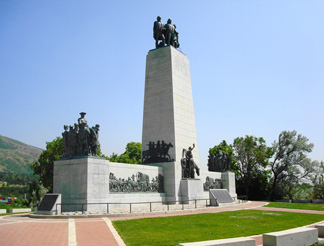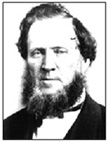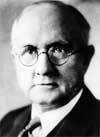Our Pioneer Legacy
Beginning in 1847, Utah became the impetus for irrigation engineering and agriculture in the U.S. westward expansion.
LeRoy W. Hooton, Jr.
July 23, 2008
|
Led by Brigham Young, when the Pioneers first arrived in the Salt Lake valley in 1847, there were different impressions of the sight before them. Most cited the beauty of the valley and the Wasatch Mountains; however some of the descriptions denoted the hardships they were to endure in conquering this land bordering the Great Basin Desert.
One early description was written by Orson F. Whitney:
“Aside from its scenic splendor there was little to invite and much to repel in the prospect of their [pioneer's] view. On all sides a seemingly interminable waste of sagebrush bespangled with sunflowers, the paradise of the lizard, the cricket and the rattlesnake.”
With the successful diversions of water from City Creek, two weeks after arriving in the valley on August 7, Brigham Young spoke of the City's location and the benefits of City Creek:
“We have selected a site for a city which, for beauty and convenience, we have never been seen equal. It is on a gentle declivity where every garden, house, lot or room may be abundantly supplied with cold water from the mou
|
Later on September 9, 1847 Brigham Young instructed the pioneers on the use of water and designated City Creek as the settlement's water supply.
He wrote in an Epistle:
“[The Pioneers were]...to prepare churns, vats, tanks, reservoirs, and ditches for irrigation, and City Creek would yield an abundance of water for that purpose.”
As the City was laid out in blocks and ditches constructed to provide the water from City Creek to flow to each lot, a beautiful city rose from interminable waste described by Orson F. Whitney.
In 1850, Captain Howard Stansbury wrote in his journal:
“The site for the city is most beautiful ...Through the city itself flows an unfailing stream of pure, sweet water, which by an ingenious mode of irrigation is made to traverse each side of every street, whence it is led into every garden spot, spreading life, verdure and beauty over what was heretofore a barren waste.”
By the turn of the century, in 1903 Chief of Irrigation Investigations, U. S. Department of Agriculture, Elwood Mead wrote a report on irrigation in Utah. Mead, who would later become Commissioner of the Bureau of Reclamation between 1924 and 1936 and the name sake for Lake Mead at Hoover Dam, described the monolithic efforts of the Mormon Pioneers necessary to tame the arid west:
|
As the nation began to look westward for expansion, the Mormon Pioneers’ success with the practice of irrigation became a model for the federal government to follow. The reclamation movement began on September 15, 1891 when the first National Irrigation Congress was held in Salt Lake City. Many believed that in order to populate the West, the federal government had to be involved in reclaiming the West with water development projects.
William E. Smythe, author and advocate for western reclamation, promoted the Mormon Pioneers' success in his quest to reclaim the arid West. He was a national spokesman for developing the arid lands west of the Hundredth Meridian.
Smythe touted the Mormon Pioneers' efforts in reclaiming the Great Basin:
“The Mormon pioneers' are the irrigators of the United States ... when studied in connection with Mormon colonization, it is plain that the [irrigation] system was born of the necessities of the place and time--that it is the legitimate product of the peculiar environment of the arid region. The forces that have made the civilization of Utah will make the civilization of western America.”
With the Mormon Pioneers' proven success with irrigation, political support grew in Washington, D. C. By 1890, the irrigation movement had gained enough strength to have pro-irrigation planks in both parties' platforms. Legislation was drafted by Nevada Congressman Francis G. Newlands and supported by President Theodore Roosevelt who was sympathetic to the West. On June 17, 1902 Congress passed the Reclamation Act putting into motion the building of a nation.
In contemporary times Marc Reisner, author of the 1986 book entitled, “Cadillac Desert” acknowledges the Mormon Pioneers' enormous success in developing irrigation practices and their impact on the nation when their practices were adopted by the federal government on a grander scale.
|
“Without realizing it, they were laying the foundation of the most ambitious desert civilization the world has seen. In the New World ... the Mormons attacked the desert full-bore, flooded it, subverted its dreadful indifference – moralized it – until they had made a Mesopotamia in American between the valleys of the Green River and middle Snake.” He continues, “In ... 1902 the United States launched its own irrigation program, based on Mormon experience, guided by Mormon laws, run largely by Mormons.”
The 1902 Reclamation Act developed irrigation systems in reclaiming arid lands in the 17 western states west of the Hundredth Meridian. The Bureau of Reclamation has constructed projects that now irrigate 9.2 million acres of land and drinking water for over 31 million people. These projects also generate electrical power serving 6 million homes.
With the passage of the 1902 Reclamation Act Utah's legacy grew with the construction of projects, beginning with the Strawberry Project in 1907 to the Central Utah Project. In total 240,000 acre-feet of municipal and industrial water supply has been developed serving over a million people;and 430,000 acre-feet of water for irrigating 330,000 acres of farmland.
There are many reasons to celebrate our history on July 24, but we should not forget the struggle the Mormon Pioneers endured to survive in the Great Basin and through their success in irrigation a nation was built.



